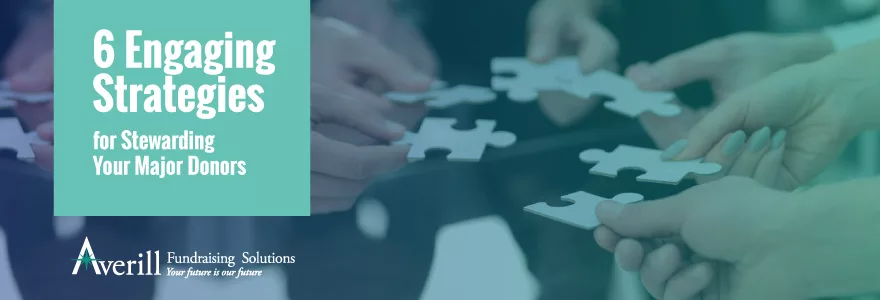
Every nonprofit knows that stewarding your major donors is the best way to ensure that your fundraising success continues into the future. It’s far easier to rely on existing relationships for support than it is to find new supporters every time you hold a fundraising campaign.
But how can you make sure that you’re retaining your supporters so that they’ll want to stay involved with your nonprofit organization year after year? The best retention strategy, of course, is supporter stewardship.
Stewardship is the stage of a relationship with a contributor in which you prove that you’re using their gifts appropriately and maintain a connection between them and your nonprofit organization. A healthy stewardship program is the surest way to ensure that your supporters will contribute to your nonprofit year after year.
So how can you be sure that you’re stewarding your supporters appropriately? Use our 6 best tactics to make sure that you’re strengthening your relationships with your community members and maintaining your connections into the future.
- Use your data to understand your retention analytics.
- Start with multiple thank-yous.
- Make your gratitude public.
- Create supporter societies.
- Host stewardship events.
- Engage your supporters as part of the team.
Stewardship is crucial for every nonprofit, and these 6 tips will help you strengthen and expand your own stewardship program. If you’re ready to learn more about these techniques, let’s get started!

1. Use your data to understand your retention analytics.
The first step of any strategy for your nonprofit, from direct mail fundraising to event planning, is to use the data from your previous endeavors to understand the foundation upon which you must build your new strategy.
For your stewardship strategy, you have to understand your nonprofit’s history of supporter retention. Knowing where your previous strategy succeeded and had weak spots will allow you to create a stronger plan for going forward.
Look into your supporter CRM, or constituent relationship manager. If your nonprofit practices strong data management, you should be able to tell how frequently someone contributes to your cause, the size of those gifts, and whether or not they are an active supporter of your nonprofit.
In order to understand how your nonprofit’s retention plan is currently going, ask your community the following questions:
- Out of all of our gifts this year, how many were given by new supporters, and how many were given by old friends?
- For how long do donors give recurring gifts?
- Of all our major givers, how many remain engaged with the organization after their gift?
The questions you use to understand your retention rates will vary by organization, but the underlying principle is the same. If you already have a sky-high retention rate, fine-tuning your stewardship strategy shouldn’t be difficult at all. If you find that your whole supporter population consists of first-time givers and no repeat supporters, you’ll need to find a better way.
Analyzing your data can be difficult if you haven’t done it before. If you need a little help from an expert (and there’s no shame in that!), check out this guide to hiring a fundraising consultant from Averill Fundraising Solutions.

2. Start with multiple thank-yous.
When you engage with your supporters after they make a contribution to your nonprofit, your attitude should be based in gratitude. It’s only through the efforts of your supporters that your nonprofit organization is able to achieve its mission.
You should say, “Thank you,” to your supporters as frequently as you can. An automated follow-up strategy might be a good idea for your nonprofit, especially if you have a large enough supporter base where someone might slip through the cracks if it’s all done manually.
Try setting a schedule of reminders to tell your staff when to send out thank-you emails, or schedule them automatically to be sent through your nonprofit CRM, marketing, or fundraising software. An appropriate schedule of thank-you days might look something like this:
- As soon as your supporter makes a contribution, they should receive a thank-you email with the information necessary to claim their tax deduction.
- A week after their gift, you should send either another email saying thank you or a handwritten card to the supporter.
- Six months after the gift, you should send another email or handwritten note thanking the supporter again and including updates on what your nonprofit has been up to with the contribution that they made.
- At the end of the year in which the supporter gave their contribution, you should send a holiday card wishing them the best and thanking them one more time.
Keep your thank-yous centered on the supporter and what they did for your nonprofit, and not about what your nonprofit was able to do with their gift. This tactic makes them feel special and appreciated.
Also, keep your annual fund appeals and your year-end thank-yous separate. When you combine them, you risk making your supporters feel as though you’re only saying thank-you so that you can ask them for another contribution.
When you create a culture of gratitude in and around your nonprofit, your supporters are more likely to stick around and contribute again in the future.

3. Make your gratitude public.
Don’t just thank your supporters privately. While private thank-yous are important and personal, your supporters will also appreciate the world knowing how they spend their time or money. Incorporate ways to publicly thank your supporters into your stewardship program so that they’re able to demonstrate their philanthropic behavior.
Plus, when other members of your community see the names of their friends and colleagues displayed in public and prominent members, they’ll want to get involved and see what all the hype is about.
Some fun ways to show gratitude to your supporters are:
- Include a page on your website thanking all of your supporters by name.
- Use your nonprofit annual report as a vehicle for naming and thanking your supporters.
- Create a wall in your office or other facilities that includes the names of your supporters.
- Announce a “supporter of the week” on your social media platforms and thank them.
Creating public displays of gratitude supports your stewardship efforts in two ways. First, it reminds your supporters that you care deeply about what they provide to your nonprofit. It makes them feel good about enacting real good in the world.
Second, it demonstrates to potential supporters that your nonprofit values your supporter community above all else and encourages your supporters to get involved.
For more help with public supporter recognition, check out this ultimate guide on the topic from Double the Donation.

4. Create supporter societies.
Supporter societies are a fundraising strategy that also double as a great stewardship tactic. A supporter society program is a group of exclusive ‘clubs’ that your nonprofit organization determines based on giving level. For example, if your nonprofit is politically affiliated, you could create levels like these:
- Everyone who has given $50-$200 is a “Representative.”
- Everyone who has given $200-$1,000 is a “Senator.”
- Everyone who has given more than $1,000 is a “President.”
The names of each level can be as creative as you want, but the idea remains the same. When you organize your supporters by giving level, you can standardize your stewardship program for each level and ensure that everyone is involved and appreciated.
Everyone who is a Representative should receive a pin and a water bottle, everyone who is a Senator should receive a pin, water bottle, and invitation to a cookout, and everyone who is a President should receive a pin, water bottle, invitation to cookout, and a tour of your facilities by an executive.
This is just one example of how you can involve and engage your supporters based on levels, but the sky’s the limit.
Supporter societies are a fun way to encourage your community to network with each other and stay involved, as well as to make sure that you know who your most involved supporters are and steward them appropriately. You never know, you might even convert a Friend to a Saint because they want to be involved more!

5. Host stewardship events.
As we briefly mentioned with supporter societies, hosting events for your supporters is a great way to keep them engaged in the life and efforts of your nonprofit organization. You should use these events as a way to get to know your supporters better, as well as to demonstrate to them your good stewardship of their funds.
When we say stewardship events, we don’t just mean galas and auctions (although they can be fun too!). The best way to convince your supporters that their gifts are being used appropriately is just to show them.
When thinking of ways to engage your supporters, consider these options:
- Give your supporters a tour of your office, so that they can see what your staff does all day.
- Invite them to volunteer opportunities, so they can get their hands dirty with your staff and other volunteers and see what it takes to keep your nonprofit going.
- Introduce them to the constituents that your nonprofit serves, whether those are people experiencing homelessness or dogs in need of homes.
These ideas get at the heart of stewardship. Your organization must be a good steward of the funds that you are entrusted with. Being transparent about your activities with your supporters is the easiest way to prove that your organization is a faithful steward.
When your supporters trust that your nonprofit has used their gifts to the best of their abilities, they’ll have a better donor experience and will be more likely to continue to contribute in the future.

6. Engage your supporters as part of the team.
One last way to steward your supporters into remaining an effective and engaged part of your team is to truly treat them as a member of your nonprofit’s team. Instead of only asking them for financial gifts or time, ask them for their thoughts and opinions on upcoming projects.
When you ask your supporters for their honest input, you can benefit both by getting the voice of the community involved with your project as well as reminding your supporters that they are important to your nonprofit organization.
Next time that you want to engage your supporters in an honest dialogue, try some of the following strategies:
- Send out a survey to gauge how your nonprofit could improve an ongoing effort.
- Talk to your most engaged volunteers and supporters face-to-face about an issue or upcoming project.
- Give a presentation on a plan with time for discussion to one or more of your supporter societies.
- Interview them during the campaign planning and feasibility study before kicking off a capital campaign.
Reminding your supporters that their input is important to your nonprofit organization is a key way to keep them engaged with your organization and increase the chances that they will remain involved.
Supporter stewardship and retention are just as important, if not more important than finding new donors for your nonprofit organization. In order to improve your retention rates and prove your trustworthiness as a steward of funds, use these 6 tips during your stewardship efforts.
Guest article by Bob Happy of Averill Fundraising Solutions.



